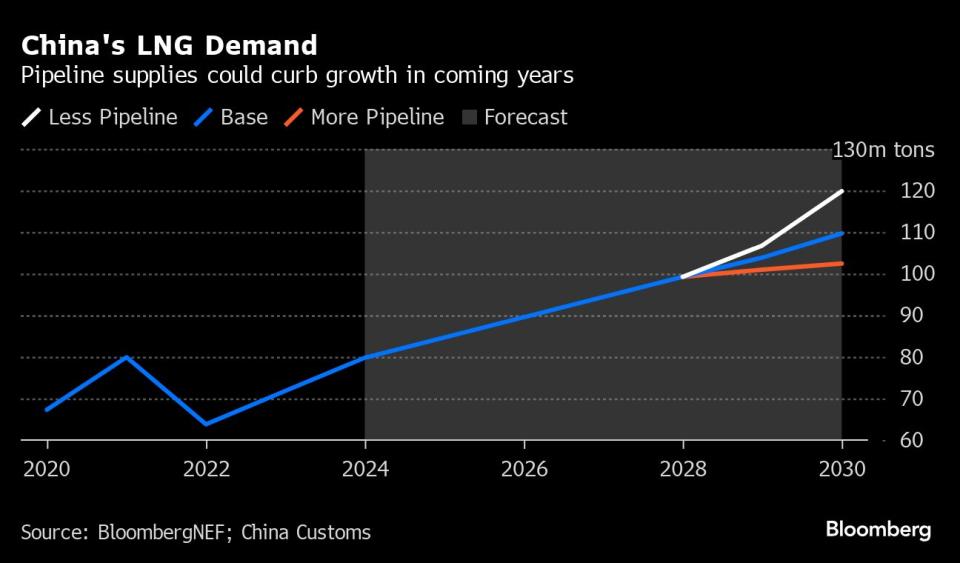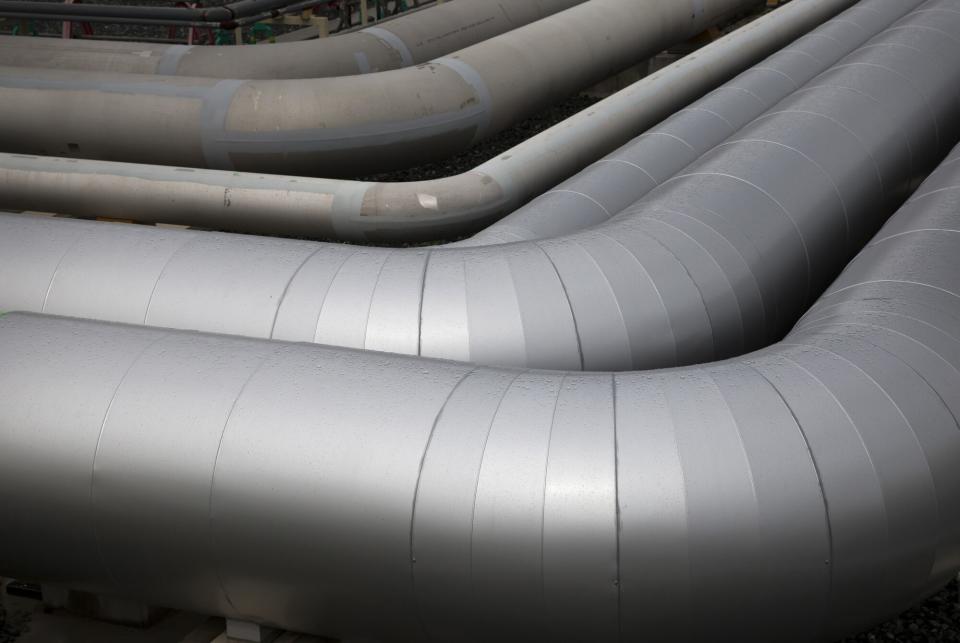China’s LNG Boom Threatened by Growing Menu of Alternative Fuels
(Bloomberg) -- Cracks are appearing in the bullish picture for liquefied natural gas demand in China.
Most Read from Bloomberg
Hedge Fund Talent Schools Are Looking for the Perfect Trader
What to Know About the Deadly Flesh-Eating Bacteria Spreading in Japan
Putin’s Hybrid War Opens a Second Front on NATO’s Eastern Border
Nvidia’s 591,078% Rally to Most Valuable Stock Came in Waves
Global majors like Shell Plc and TotalEnergies SE have invested billions of dollars in new seaborne gas supply, wagering that consumption in the world’s biggest importer will continue to expand rapidly. That long-held view hinges on China using ever more of the cleaner-burning fuel as a bridge between dirty coal and the renewable energy that will deliver net zero by 2060.
But the realities on the ground are changing. China looks like it’s ahead of schedule on emissions, which may have peaked more than half a decade ahead of its 2030 target. It’s also subsidizing overcapacity in coal power as a backstop to intermittent wind and solar, a strategy that essentially skips using gas as a transitional fuel.
And Beijing is developing other sources of gas as well. It’s raising domestic production and relying more heavily on pipeline supplies, particularly from its strategic partner Russia, which are much cheaper than seaborne shipments.
“Gas demand growth is on a downward trajectory due to the lack of economic competitiveness and a strong government push,” said BloombergNEF analyst Daniela Li.
The government’s wavering support was evident in the latest ruling from its economic planning agency, which placed new constraints on the fuel’s role in the power supply, including the flagship policy of switching from coal to gas in rural areas.
Siberian Power
If it gets off the ground, Russia’s proposed pipeline, the Power of Siberia 2, would help reduce China’s additional LNG requirements through 2030 by nearly 20%, according to BNEF. Even though China has invested a lot in terminals to receive LNG, relying on the uncertainties of the international market for supply is probably a less attractive option for a government that has energy security as one of its top priorities.
Chinese buyers reined in their appetite last month when international gas prices climbed. After surging 32% in April, import growth slipped heavily to just 3.4% in May. Imports via pipeline rose 13%. Although just one month, the data illustrates how a burgeoning menu of alternative fuel sources are likely to eat into demand when overseas LNG gets too pricey.
China’s LNG imports may rise 13% to 14% this year, according to Rystad Energy analyst Xiong Wei. That’s less than the 18% growth seen three years ago, when China overtook Japan as the world’s top buyer and before Russia’s invasion of Ukraine caused prices to spike and imports to fall.
“We expect China’s growth to continue to outpace other countries, but the increase won’t get back to 2021’s level,” she said.
Low Base
A double-digit increase may seem like a lot, but gas is coming from a low base. The fuel accounts for just over 4% of the nation’s installed power capacity, and investments in much larger sectors like clean energy and coal are likely to hamper its ability to take a greater share.
China’s thermal power investment, primarily in new coal plants, climbed 15% last year, even as usage is shrinking. In May, the country saw electricity generation from hydroelectric dams and solar farms jump 39% and 29% respectively.
LNG terminal capacity, meanwhile, is expanding faster than demand and is expected to almost double from current levels to 251 million tons a year by the end of the decade, according to BNEF.
That will inevitably lead to lower utilization rates, which could drop to just 38% by 2030, according to China National Offshore Oil Corp., the country’s biggest LNG importer.
Buyers, including Cnooc and PetroChina Co. are signing decades-spanning contracts to import LNG. But it isn’t guaranteed those supplies will end up in China, as the companies expand trading desks to allow them to resell the fuel in Asia and Europe.
On the Wire
China’s energy use per person surpassed Europe’s for the first time last year as demand from technology and manufacturing industries continued to climb.
As in past disputes, China looks to be readying a series of actions to punish the European Union for its proposed tariffs on electric cars.
China is targeting Europe’s soft (pork) belly, writes Bloomberg Opinion columnist Javier Blas.
This Week’s Diary
(All times Beijing unless noted.)
Thursday, June 20:
China sets monthly loan prime rates, 09:15
National Energy Administration chief briefs in Beijing on driving high-quality development, 15:00
China’s 3rd batch of May trade data, including country breakdowns for energy and commodities
SMM wire and cable industry conference, Hangzhou, day 1
Friday, June 21:
China weekly iron ore port stockpiles
Shanghai exchange weekly commodities inventory, ~15:30
SMM wire and cable industry conference, Hangzhou, day 2
Saturday, June 22:
German Minister for Economic Affairs and Climate Action holds press briefing in Shanghai, 18:30
--With assistance from Stephen Stapczynski.
Most Read from Bloomberg Businessweek
Coke—and Dozens of Others—Pledged to Quit Russia. They’re Still There
Google DeepMind Shifts From Research Lab to AI Product Factory
©2024 Bloomberg L.P.

 Yahoo Finance
Yahoo Finance 

